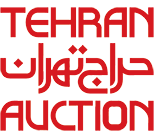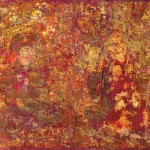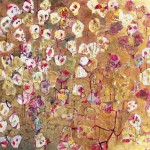The present diptych titled The Red Cypress clearly demonstrates that Reza Derakhshani is greatly inspired by the tradition of Persian painting. During his US exhibition of late 1980s in which Derakhshani showed a collection titled Khosrow and Shirin, he presented for the first time works that provided a new interpretation of Persian painting. Having miniature painting with deformed symbolic elements in mind, Derakhshani opens a contemporary window to the art to detach it from its classic origin. For instance, a usually green cypress turns red and the unified world of solid, figurative and architectural forms recall a gradual decadence. Forms are destroyed at any instant and the work molts frequently to experience a continuous birth within itself. This is Derakhshani’s creative technique with brushstrokes that make the structure of forms transient, precarious, and volatile.
Although cypress has its roots in Persian literature, it enjoys a long history in semiology of Iranian art. Recurrence of carvings of Persepolis is a sign that Iranians in the past believed in sacred aspects of this tree. It is even said that Zoroaster brought cypress from paradise and planted it in an ancient fire-temple. Upon converting to Zoroastrian faith, Shahnameh’s Gashtasp constructed a huge building around a cypress tree. Various metaphors, including immortality, pride, freedom and even martyrdom, have been assigned to cypress. Composition and choice of color perhaps indicate that the red cypress in this work is closely connected to the notion of resistance and representation of a nostalgic history.
In this collection, Reza Derakhshani chooses some elements of Persian painting and, with a smart treatment of forms, reduces figurative symbols to mere abstraction. Nevertheless, he never abandons meaningful figurative forms; hence, his painting dissociates itself with Modernism to suggest a kind of contemporary Neo-Expressionism. For example, a rider, a few figures, and some music players can be seen in the right panel, while on the other, a red cypress and a window above it are juxtaposed with an illegible text. Green patches of paint symbolize flowers and greenery of Persian painting in the background.
In a majority of Derakhshani works of this period, visible poetic inscriptions apparently produce a semantic symmetry, but they are illegible. In fact, what is of special significance to the artist is visual form of calligraphy rather than its readability and meaning. This way, he purges the meaning of contextual symbols and replaces the symbolic and semantic aspect of inscriptions with their visual aspect. Notwithstanding, Derakhshani’s pseudo-inscriptions are usually little in number and fill the margin of work.
Exploiting traditions of figurative painting, Derakhshani undertakes to revive past traditions of Iranian painting without direct representation of elements and symbols only through exploration and recognition of their visual roots. In narrating visual spheres, he takes a glimpse of the geography that has given rise to such pictures. It is a territory as vast as Iran’s deserts and mountains, with scattered hills, aged trees, and animals that are camouflaged all across this landscape.
Influence of age-old Persian literature on Derakhshani bestows richness, lyrical quality, and visual splendor upon his work. Yet he never approaches the conventional concept of illustration, exhibiting a painterly quality in his treatment of narratives. In fact, he never strives to narrate stories or describe mythological figures. Therefore, he presents only a general image of a scene or story that assumes a new form every single moment.
Although a well-known artist in the international art market, Reza Derakhshani enjoys a growing domestic market too. He sold artworks worth IRR 6 billion at Tehran Auction in 2014, surpassing his international record of $146,000.






